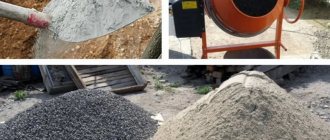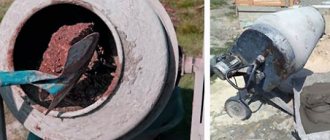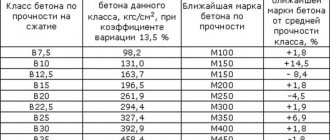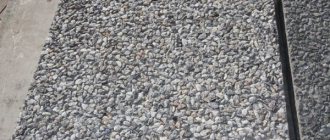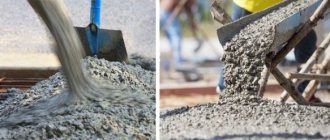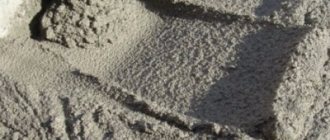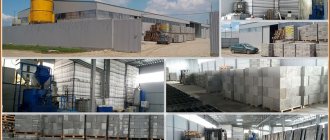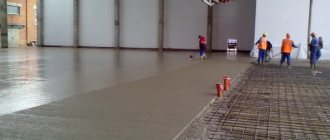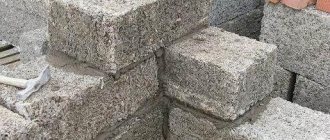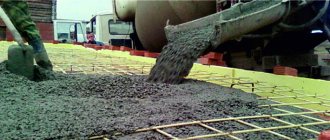Mixing the solution in a concrete mixer is quick and convenient. Light and heavy construction mixtures are prepared in it. To prepare high-quality concrete, you need to know the proportions of the components, the sequence of their loading, requirements for installation and the start of work. The process should be carried out strictly according to technology, taking into account the permissible time of continuous operation and the productivity of the unit.
Main components and proportions of the mixture
The main components for the production of concrete mixtures are cement (C), sand (S), crushed stone (SH), water (W), and auxiliary additives. The performance characteristics of concrete depend on their quality and quantity. They focus on this ratio of ingredients depending on the brand of concrete (the larger the number in the marking, the higher the strength of the solution):
- for M200 the proportions C:P:SH are 1:3:5;
- M300 - 1:2:3.5;
- M400 - 1:1,3:3;
- M450 - 1:1.1:2.5.
The volume of water consumed to prepare the mixture is determined from the ratio of 0.6-1.15 parts of water to 1 part of cement. The higher the strength required, the less water is added.
To mix concrete at the household level, the quantity of components is measured in buckets with a volume of 10-12 liters. For example, you can calculate the proportions of concrete components in buckets for pouring a foundation using the table.
| Concrete grade | Purpose | Cement | Sand | Crushed stone |
| M100 | Pouring concrete bases, foundations for fences, garages, outbuildings | 10 | 32 | 50 |
| M200 | Foundation of one- and two-story houses with light floors | 10 | 25 | 42 |
| M300 | Foundation of cottages up to 5 floors high; monolithic floors | 10 | 19 | 34 |
| M400 | Construction of buildings up to 20 floors high | 10 | 11 | 24 |
Cement
Cement acts as the main binder in concrete and affects its physical properties. The role of the cement binder is to form a mortar matrix, which serves to evenly distribute the load between large and small filler particles.
The composition of cement includes:
- 50-70% alite - this substance provides short-term strength;
- 15-30% white - affects the strength properties of concrete throughout the entire service life;
- aluminates, aluminoferrites - determine the speed of setting when cement comes into contact with water.
To prepare concrete, cement grades from M200 to M500 (sometimes M600) are used. The numbers in the marking correspond to the minimum compressive strength in kg/cm2.
The quality of cement is determined by its shelf life. It is advisable that it be done no later than 3 months ago. When squeezed, it should not form lumps.
Crushed stone
Use crushed granite or gravel. It must be clean. Foreign objects and large pieces should be excluded.
Requirements for the size of granite crushed stone, depending on the purpose of using the solution:
- floor slabs - 5-10 mm;
- foundation for residential buildings - 5-20 mm, for industrial facilities - 20-40 mm;
Crushed gravel is used in the following fractional composition:
- construction and finishing works - 3-10 and 5-20 mm;
- foundation - 40-70 mm.
For the construction of private residential buildings, crushed stone with a particle size of 20-70 mm is usually used. It is introduced into concrete mortar as a coarse filler, which helps improve the strength characteristics of the mixture.
Sand
It is optimal to use clean river or quartz sand. The presence of clay particles in it worsens the properties of concrete. Therefore, choose coarse natural sand with a minimum content of small clay particles, grain size up to 3 mm. You can mix fine sand with higher quality coarse sand.
The purpose of using sand is to reduce cement consumption, fill pores between large fillers, and strengthen concrete.
Water
The water for mixing concrete should not contain dissolved salts, alkalis, or acids. They prevent the mixture from setting and hardening properly. Water cannot be used:
- sewage;
- contaminated with harmful impurities;
- containing plant matter that may decompose;
- which contain oils and organic impurities.
Concrete is mixed using tap drinking or industrial water. Fresh river, lake, rain, melt - used after settling. Salt water (sea or lake) can be used in dry and hot climates or if reinforcement is not used in the joints. Water from clay-bottomed wells is introduced after careful filtration.
Excipients
Auxiliary substances improve the properties of the concrete mixture. Add to the main ingredients:
- plasticizers to increase the viscosity or fluidity of concrete;
- slaked lime to simplify the laying of the composition;
- bridging additives for filling pores in the mixture with waterproof materials;
- reinforcing fibers (polypropylene) to improve strength characteristics;
- modifiers for rapid hardening of concrete mortar - when working in conditions of low temperatures, high humidity, and also when there is an excess of water in the mixture;
- air-entraining and gas-forming to increase the frost resistance and water resistance of concrete.
If it is expected that the work will be carried out for a long time, substances are added that slow down the setting process.
Proportions of components for preparing 1 cubic meter. concrete
Foundation concrete has several grades, which are determined by the type of future structure, its weight and purpose. To prepare each brand of concrete, a specific brand of cement can be used. In general, these two factors determine the number of components required to prepare one cubic meter of concrete.
In most cases, concrete grade M 200 is used for the construction of foundations; it has sufficient strength and can withstand freezing and thawing many times. To make such a solution, M500 grade cement, medium-fraction crushed stone and water from the water supply are used.
To prepare one cubic meter of M200 concrete, you need to take the following number of components:
Read also: Galvanizing metal at home
- Cement – 300-350 kg.
- Crushed stone – 1100-1200 kg.
- Sand – 600-700 kg.
- Water – 150-180 l.
To convert the indicated values into volume in buckets for more convenient measurement, it is enough to know the approximate mass of each component in one bucket. For example, a 10 liter bucket holds 15.6 kg of cement, 19.5 kg of sand and 17 kg of fine crushed stone. Therefore, to mix a concrete mass with a volume of 1 m 3 you will need approximately 20 buckets of cement, 30 buckets of sand, about 70 buckets of crushed stone and 15-20 buckets of water. As you can see, calculating the proportions of concrete for the foundation in buckets is not so difficult.
Equipment installation and safety precautions
Before starting work, the concrete mixer is properly installed to ensure uniform mixing of materials. It is necessary to ensure its perfectly level position and securely fasten it. To do this, the unit is placed on a horizontal area. If there is no such surface at the construction site, you can organize it using a level, boards and available materials.
During the first batch, it is recommended to add 10% more cement and sand to the mixture than was calculated according to the proportion. This serves as a correction for the adhesion of these components to the propeller blades. You can additionally lubricate the screw.
Be sure to wear safety glasses, gloves and follow safety precautions:
- make sure that there are no dangerous factors at the installation site of the concrete mixer;
- check that the unit is installed correctly;
- check the presence of switching equipment and grounding devices;
- provide a passage to the installation with a width of at least 1 m;
- monitor the serviceability of mechanisms during operation;
- do not insert a shovel or put your hands into a moving drum;
- Do not lean too low over the drum.
Work related to the inspection and maintenance of the concrete mixer is not done with the mechanism drives turned on. If malfunctions are detected or current appears on the housing, the mixer is turned off and work is stopped.
Loading order
To obtain a high-quality mixture and prevent mechanical damage to the drum, its components are loaded in the following sequence: cement, sand, crushed stone, water. To correctly load all components into a concrete mixer, adhere to the following algorithm of actions:
- Pour some water into the drum. This will reduce the adhesion of the mixture components to the walls and blades.
- Cement is poured.
- Turn on the concrete mixer and stir until a viscous homogeneous mixture is formed.
- Add sand into the drum, add water, and continue stirring.
- Gravel or crushed stone is laid and auxiliary substances are added.
Some recommend this loading order: first mix all the dry ingredients, pour them into a concrete mixer, and add water. But this loading method complicates mixing of concrete.
Procedure for mixing concrete
Concrete is mixed either manually or using a concrete mixer. With the manual method, the procedure is as follows:
- In one container you need to mix sand, cement and additives (plasticizers) until the mixture becomes completely homogeneous;
- Now you need to add water to this container in small portions and stir;
- Already here you can add filler (crushed stone or gravel with granite), each particle of which must be covered with the composition.
When using a construction mixer you must:
- Combine water and cement in a mixer container;
- Add sand and filler there, stir for a few minutes;
- Add a few more liters of water to achieve the desired consistency.
Main process
Concrete produced in a concrete mixer has higher quality indicators compared to mortar mixed with your own hands. In addition, the labor intensity and duration of the process are reduced.
A solution is prepared in a concrete mixer using the following technology:
- The component composition is selected and the proportions of materials are calculated.
- Prepare the fillers. If necessary, they are sifted, washed, and dried. Water, if necessary, is settled.
- Gradually, taking into account the density, load the components into the mixer and add water.
- Add excipients.
- After loading the inert materials, they begin to knead them.
- Check the readiness of the mixture. To do this, make several notches with a shovel on the surface of the solution. The finished mixture has a smooth surface with preservation of peaks between the notches. The consistency of the finished solution is cheesy, but quite plastic.
- Unload the mixture. It is convenient to use a metal bath or trough.
- Clean the concrete mixer and equipment.
Before filling in a new batch of solution components, remove the remnants of the finished mixture. To do this, clean water (5-7 l) is poured into the drum, to which sand is added. After draining, it can be used to knead the next batch of mixture.
Online calculator
To calculate the proportions of the concrete mixture, use the online calculator.
Read also: Building a fence with your own hands
Some people prefer to do this with a shovel, but this tool does not provide sufficient efficiency, which affects the quality of the result.
If you still have no choice, then you can use the equipment described above, but make sure that it is absolutely dry, like the kneading bucket. All materials are measured using buckets, and then compacted well and leveled with a shovel. To make it convenient to work with the mixture, you will need a capacious container. We mix sand and crushed stone, make irregularities on the surface of the mass, into which we pour cement. Mix all components thoroughly until a homogeneous consistency is obtained.
Work on pouring the foundation should be carried out in the warm season so that it does not begin to freeze, and the resulting ice crystals do not begin to destroy it from the inside.
Thus, we have considered the proportions and composition of concrete, as you can see, everything is quite simple. It is only important to take into account some subtleties and have some dexterity when kneading. Carefully study the composition of the materials you buy and their properties, then you will be pleased with the result. Even if you miss something somewhere and end up with concrete of a lower grade than you planned, it will be quite suitable for installing a foundation for a house or gazebo.
[content-egg module=AdmitadProducts template=price_tracker_alert]
Proportions of concrete in buckets
Every building, regardless of its purpose, needs a strong support; the reliability of the building and its durability depend on its quality. The foundation can have different shapes and consist of different materials. However, in any case, the main component of the foundation is concrete.
How long does it take to mix concrete in a concrete mixer?
The time during which the solution must be mixed in a concrete mixer depends on its design and engine power. All these indicators are given in the operating instructions.
The duration of continuous operation without engine overload, depending on the type of concrete mixer, is:
- gravity - 2-2.5 minutes;
- forced type - 1-2 min.
Time is counted from the moment when all the ingredients have been loaded into the mixer drum. Prolonged mixing of concrete is not recommended. This is accompanied by evaporation of water and, accordingly, a decrease in its plasticity characteristics.
How much concrete can you mix with a concrete mixer in a day?
The yield of solution per day prepared in a concrete mixer depends on:
- drum volume, for household and semi-industrial purposes mixers with a capacity from 45-60 l to 120, 160, 180 l are used;
- engine power;
- time of mixing and unloading of the mixture;
- number of batches that can be prepared within an hour.
The amount of concrete that can be mixed with one device during a working day is determined in the following sequence:
- Calculate the total duration of the working cycle. To do this, sum up the time allotted for loading, mixing, and unloading.
- Determine how many times per hour the kneading can be done by dividing 60 by the duration of the working cycle.
- Find the amount of material that can be prepared in 1 hour (m3/hour). To do this, the volume of the drum is multiplied by the number of kneading cycles. It is taken into account that the finished mixture occupies 40-60% of its volume.
- Multiply the number of permissible hours of work per day by the hourly productivity.
This method of determining daily productivity is used for both gravity and forced concrete mixers. In gravity-type models, 60-500 liters of solution are produced at one time, depending on the volume of the drum.
Proper operation of the concrete mixer, compliance with the proportions of fillers and water, and compliance with safety requirements guarantee the production of a high-quality concrete solution. There are advantages to preparing concrete in a concrete mixer. They are to increase productivity and reduce the labor intensity of the process.
